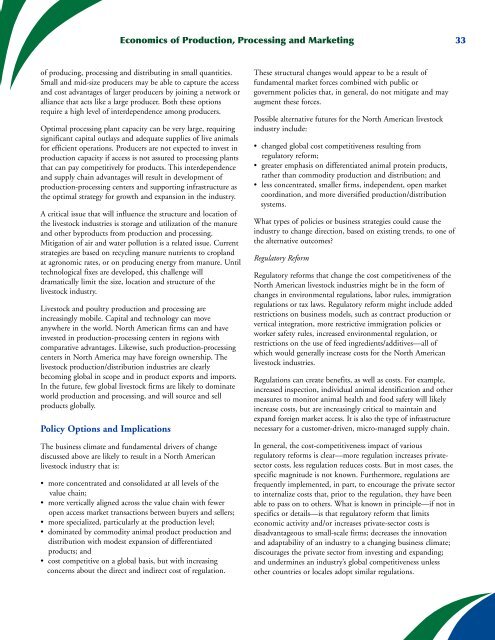The Future of Animal Agriculture in North America - Farm Foundation
The Future of Animal Agriculture in North America - Farm Foundation
The Future of Animal Agriculture in North America - Farm Foundation
You also want an ePaper? Increase the reach of your titles
YUMPU automatically turns print PDFs into web optimized ePapers that Google loves.
Economics <strong>of</strong> Production, Process<strong>in</strong>g and Market<strong>in</strong>g 33<br />
<strong>of</strong> produc<strong>in</strong>g, process<strong>in</strong>g and distribut<strong>in</strong>g <strong>in</strong> small quantities.<br />
Small and mid-size producers may be able to capture the access<br />
and cost advantages <strong>of</strong> larger producers by jo<strong>in</strong><strong>in</strong>g a network or<br />
alliance that acts like a large producer. Both these options<br />
require a high level <strong>of</strong> <strong>in</strong>terdependence among producers.<br />
Optimal process<strong>in</strong>g plant capacity can be very large, requir<strong>in</strong>g<br />
significant capital outlays and adequate supplies <strong>of</strong> live animals<br />
for efficient operations. Producers are not expected to <strong>in</strong>vest <strong>in</strong><br />
production capacity if access is not assured to process<strong>in</strong>g plants<br />
that can pay competitively for products. This <strong>in</strong>terdependence<br />
and supply cha<strong>in</strong> advantages will result <strong>in</strong> development <strong>of</strong><br />
production-process<strong>in</strong>g centers and support<strong>in</strong>g <strong>in</strong>frastructure as<br />
the optimal strategy for growth and expansion <strong>in</strong> the <strong>in</strong>dustry.<br />
A critical issue that will <strong>in</strong>fluence the structure and location <strong>of</strong><br />
the livestock <strong>in</strong>dustries is storage and utilization <strong>of</strong> the manure<br />
and other byproducts from production and process<strong>in</strong>g.<br />
Mitigation <strong>of</strong> air and water pollution is a related issue. Current<br />
strategies are based on recycl<strong>in</strong>g manure nutrients to cropland<br />
at agronomic rates, or on produc<strong>in</strong>g energy from manure. Until<br />
technological fixes are developed, this challenge will<br />
dramatically limit the size, location and structure <strong>of</strong> the<br />
livestock <strong>in</strong>dustry.<br />
Livestock and poultry production and process<strong>in</strong>g are<br />
<strong>in</strong>creas<strong>in</strong>gly mobile. Capital and technology can move<br />
anywhere <strong>in</strong> the world. <strong>North</strong> <strong>America</strong>n firms can and have<br />
<strong>in</strong>vested <strong>in</strong> production-process<strong>in</strong>g centers <strong>in</strong> regions with<br />
comparative advantages. Likewise, such production-process<strong>in</strong>g<br />
centers <strong>in</strong> <strong>North</strong> <strong>America</strong> may have foreign ownership. <strong>The</strong><br />
livestock production/distribution <strong>in</strong>dustries are clearly<br />
becom<strong>in</strong>g global <strong>in</strong> scope and <strong>in</strong> product exports and imports.<br />
In the future, few global livestock firms are likely to dom<strong>in</strong>ate<br />
world production and process<strong>in</strong>g, and will source and sell<br />
products globally.<br />
Policy Options and Implications<br />
<strong>The</strong> bus<strong>in</strong>ess climate and fundamental drivers <strong>of</strong> change<br />
discussed above are likely to result <strong>in</strong> a <strong>North</strong> <strong>America</strong>n<br />
livestock <strong>in</strong>dustry that is:<br />
• more concentrated and consolidated at all levels <strong>of</strong> the<br />
value cha<strong>in</strong>;<br />
• more vertically aligned across the value cha<strong>in</strong> with fewer<br />
open access market transactions between buyers and sellers;<br />
• more specialized, particularly at the production level;<br />
• dom<strong>in</strong>ated by commodity animal product production and<br />
distribution with modest expansion <strong>of</strong> differentiated<br />
products; and<br />
• cost competitive on a global basis, but with <strong>in</strong>creas<strong>in</strong>g<br />
concerns about the direct and <strong>in</strong>direct cost <strong>of</strong> regulation.<br />
<strong>The</strong>se structural changes would appear to be a result <strong>of</strong><br />
fundamental market forces comb<strong>in</strong>ed with public or<br />
government policies that, <strong>in</strong> general, do not mitigate and may<br />
augment these forces.<br />
Possible alternative futures for the <strong>North</strong> <strong>America</strong>n livestock<br />
<strong>in</strong>dustry <strong>in</strong>clude:<br />
• changed global cost competitiveness result<strong>in</strong>g from<br />
regulatory reform;<br />
• greater emphasis on differentiated animal prote<strong>in</strong> products,<br />
rather than commodity production and distribution; and<br />
• less concentrated, smaller firms, <strong>in</strong>dependent, open market<br />
coord<strong>in</strong>ation, and more diversified production/distribution<br />
systems.<br />
What types <strong>of</strong> policies or bus<strong>in</strong>ess strategies could cause the<br />
<strong>in</strong>dustry to change direction, based on exist<strong>in</strong>g trends, to one <strong>of</strong><br />
the alternative outcomes?<br />
Regulatory Reform<br />
Regulatory reforms that change the cost competitiveness <strong>of</strong> the<br />
<strong>North</strong> <strong>America</strong>n livestock <strong>in</strong>dustries might be <strong>in</strong> the form <strong>of</strong><br />
changes <strong>in</strong> environmental regulations, labor rules, immigration<br />
regulations or tax laws. Regulatory reform might <strong>in</strong>clude added<br />
restrictions on bus<strong>in</strong>ess models, such as contract production or<br />
vertical <strong>in</strong>tegration, more restrictive immigration policies or<br />
worker safety rules, <strong>in</strong>creased environmental regulation, or<br />
restrictions on the use <strong>of</strong> feed <strong>in</strong>gredients/additives—all <strong>of</strong><br />
which would generally <strong>in</strong>crease costs for the <strong>North</strong> <strong>America</strong>n<br />
livestock <strong>in</strong>dustries.<br />
Regulations can create benefits, as well as costs. For example,<br />
<strong>in</strong>creased <strong>in</strong>spection, <strong>in</strong>dividual animal identification and other<br />
measures to monitor animal health and food safety will likely<br />
<strong>in</strong>crease costs, but are <strong>in</strong>creas<strong>in</strong>gly critical to ma<strong>in</strong>ta<strong>in</strong> and<br />
expand foreign market access. It is also the type <strong>of</strong> <strong>in</strong>frastructure<br />
necessary for a customer-driven, micro-managed supply cha<strong>in</strong>.<br />
In general, the cost-competitiveness impact <strong>of</strong> various<br />
regulatory reforms is clear—more regulation <strong>in</strong>creases privatesector<br />
costs, less regulation reduces costs. But <strong>in</strong> most cases, the<br />
specific magnitude is not known. Furthermore, regulations are<br />
frequently implemented, <strong>in</strong> part, to encourage the private sector<br />
to <strong>in</strong>ternalize costs that, prior to the regulation, they have been<br />
able to pass on to others. What is known <strong>in</strong> pr<strong>in</strong>ciple—if not <strong>in</strong><br />
specifics or details—is that regulatory reform that limits<br />
economic activity and/or <strong>in</strong>creases private-sector costs is<br />
disadvantageous to small-scale firms; decreases the <strong>in</strong>novation<br />
and adaptability <strong>of</strong> an <strong>in</strong>dustry to a chang<strong>in</strong>g bus<strong>in</strong>ess climate;<br />
discourages the private sector from <strong>in</strong>vest<strong>in</strong>g and expand<strong>in</strong>g;<br />
and underm<strong>in</strong>es an <strong>in</strong>dustry’s global competitiveness unless<br />
other countries or locales adopt similar regulations.

















